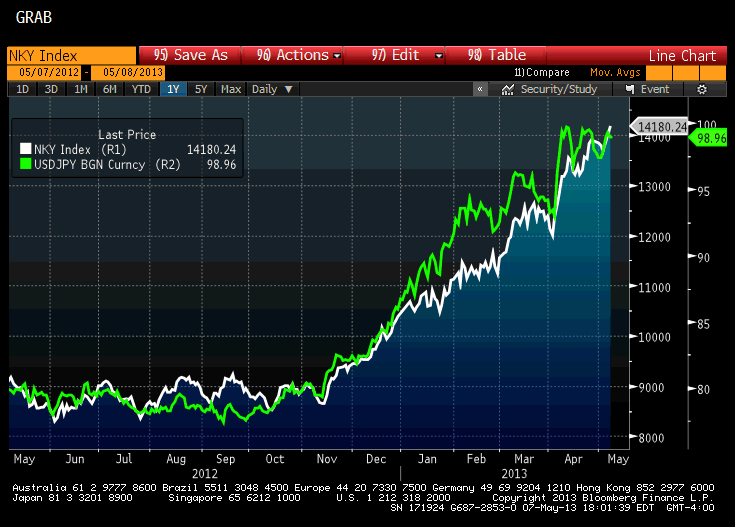- Why EUR Can’t Break 1.30
- AUD Tanks After RBA Cuts Rates
- CAD Hits Fresh 2.5-Month Highs
- NZD: RBNZ Financial Stability Report Due
- GBP: Failing at 1.56?
- Yen Soars As Stocks Top 14,000
What Rally In Stocks Says About Currencies
Over the past week, all of the action has been in equities. U.S. stocks powered to new record highs while currencies consolidated quietly. The U.S. dollar weakened against the euro and Japanese Yen and strengthened against the British pound, Swiss Franc, Australian and New Zealand dollars. This divergent price action confirms that there isn’t one directional interest in currencies. Part of the reason why currencies have not enjoyed the same type of strong trend as equities is because this is a QE driven rally and with central banks around the world engaged in new rounds of easing, the availability of more stimulus has been ambiguously positive for stocks. Unfortunately these simultaneous easing programs has also clouded the outlook for currencies as investors wonder which central bank will win the race to debase. The rally in stocks and consolidation in currencies also tells us that investors are much more interested in joining the trend in equities than try to figure out whether support or resistance will be broken in currencies. Eventually this will change but for the time being we can’t ignore the fact that the big moves are happening in other markets. However what stocks have done for currencies is keep them supported -- if not for the equity market rally, we would have probably seen a deeper sell-off in the EUR/USD and AUD/USD.The lack of U.S. economic data this week also contributed to the consolidative price action. The only notable report Tuesday was the IBD/TIPP Economic Optimism index, which surprisingly declined, showing a drop in sentiment. According to the report, Americans grew less optimistic about the economic outlook and Federal policies but thankfully more optimistic about personal finances. The reason why this pullback is so surprising is because stocks have been performing well and now we will have to wait until Thursday for any market moving U.S. data.
Why EUR Can’t Break 1.30
The euro ended the day unchanged against the U.S. dollar despite the attempts of European policymakers to jawbone the currency. ECB member Weidmann said that they must work to improve the competitiveness of the euro zone as a whole and two ways to achieve this goal would be through easier monetary policy and a weaker currency. Since last week’s central bank meeting, policymakers have used every opportunity to make it clear that they are committed to increasing stimulus again if economic data continues to weaken and yet the euro refuses to fall. One reason why 1.30 continues to be rock solid support for the EUR/USD is because this morning’s economic reports were better than expected, easing concerns about a continued pullback in the German economy. As we can see by the recent price action of the EUR/USD around this key level, investors either don’t want to see euro below 1.30 or they are fighting hard to protect orders below that level from being triggered. For this reason, positive economic reports are having a more significant impact on the euro that weaker data and therefore this morning’s surprise increase in German factory orders sent EUR/USD soaring. Economists had been looking for a 0.5% decline but growth in March matched the 2.2% growth in February. Previously, the drop in PMI manufacturing numbers raised concerns about one main component of Germany’s economy and the latest rebound helps to ease those fears. However France is still suffering according to their industrial production report, which saw activity declined three times more than expected. Nonetheless, Germany has carried regional growth for the past few years so the focus remains on the health of the euro zone’s largest economy. Euro is also benefitting from the persistent rally in European and U.S. equities. The German DAX hit a record high, Tuesday, and U.S. stocks are also poised for additional gains. While economists have many concerns about the outlook for the euro zone, investors are optimistic and willing to assume risk, which translates into less concern and more complacency about the outlook for the euro. At the end of the day, EUR/USD is still a risk currency and with risk appetite improving, investors are brushing off the ECB’s warnings. As long as stocks continue to rise, the EUR/USD will be able to hold above 1.30 but once equities turn, watch for a steep slide in the currency. Finally, investors don’t think the ECB’s threat to do more is very credible. With some policymakers saying that the market over interpreted Draghi’s recent comments, investors realize that the central bank is really trying to do is send a message to the market that they maintain an easing bias and are flexible enough to consider additional ways to stimulate their economy. In reality however, the bar for another rate cut let alone negative deposit rates is high and it will take a significant slowdown in regional growth for them to consider easing again.
AUD Tanks After RBA Cuts Rates
The Australian dollar tanked after the Reserve Bank of Australia cut interest rates 25bp to a record low of 2.75 percent. The decision was expected by some but clearly not by the majority as the currency plummeted after the announcement. In our note last night, we said that based on the deterioration in manufacturing, service and construction activity along with the drop in retail sales and smaller than expected increase in consumer prices, the RBA has every reason to ease – and they did. The main motivation behind their rate cut was concerns about global growth and a strong currency. RBA Governor Glenn Stevens said that the exchange rate “has been little changed at a historically high level over the past 18 months, which is unusual given the decline in export prices and interest rates during that time. Moreover, the demand for credit remains, at this point, relatively subdued.” According to our colleague Boris Schlossberg, “the emphasis on some suggests that the RBA is not finished easing just yet and given the absence of any price pressures in the Australian economy, would not hesitate to cut rates to 2.5% before the year end.” Aside from the rate cut, we also learned that while the trade balance returned to surplus in March, construction activity contracted at a faster pace and house price growth slowed. No Australian economic reports are scheduled for release this evening and for this reason, we expect the AUD/USD to remain weak until Thursday’s employment report. The New Zealand dollar also lost value despite an increase in average hourly earnings but the Canadian dollar broke from the trend and rose to a fresh 2.5-month high against the greenback. There was no discernable catalyst for the move outside of AUD/CAD selling. New Zealand’s RBNZ Financial Stability Review is scheduled for release this evening and we will be combing the report carefully for the central bank’s latest assessment of the economy.
GBP: Failing At 1.56?
With no major U.K. economic reports on the calendar, sterling traded lower against the dollar and euro. Having tested and consolidated below 1.56 for the past four trading days, Tuesday’s reversal in the GBP/USD points to a potential top. With no economic data on the calendar until Thursday, we will have to wait and see if this becomes a more significant turnaround for the currency pair. Given the recent improvements in U.K. data, investors will be looking for more upside surprises. If the data delivers, the GBP/USD could aim for another test of 1.56 but if industrial or manufacturing production declines, this pullback in the sterling could become a more significant top for the pair.
Yen Soars As Stocks Top 14,000
For the first time in almost five years, the Nikkei topped 14,000. This utterly impressive 3.5% rally in Japanese stocks should have been positive for USD/JPY but instead of rallying, all of the Japanese Yen crosses declined. As shown in the following chart, over the past few years, USD/JPY and the Nikkei has had a very strong relationship because both are considered risk assets but the recent price action suggests that the Nikkei rally is keeping investment flows at home and possibly even attracting foreign investments. While the Bank of Japan’s easing measures have made the country’s bonds extremely unattractive, it has also provided a big boost for Japanese stocks. Global fund managers looking to diversify could see the BoJ’s commitment to providing continuous and aggressive support for the Japanese economy as a reason to increase their exposure to Japanese equities especially now that we are starting to see an improvement in Japan’s economy. This very trend could be one of the primary reasons why the Yen refuses to fall. USD/JPY" width="735" height="527">
USD/JPY" width="735" height="527">
